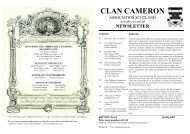Autumn 11 - The Clan Cameron Association Scotland.
Autumn 11 - The Clan Cameron Association Scotland.
Autumn 11 - The Clan Cameron Association Scotland.
Create successful ePaper yourself
Turn your PDF publications into a flip-book with our unique Google optimized e-Paper software.
European to become so entrenched that there will be no place for the<br />
African except at the white man’s pleasure”. <strong>The</strong>re was to be no<br />
repeat of the situation which had developed in the then Rhodesia.<br />
To achieve some reconciliation of both these conflicting positions he<br />
established a Legislative Council of twenty members - all appointed<br />
by him and all European and Asian. In so far as the local African<br />
population was concerned, he decided education was the way<br />
forward and he started a policy of building schools throughout the<br />
country at all centres of population just as <strong>Scotland</strong> had done some<br />
seventy years before. During his period as Governor, education<br />
increased ten fold, and he worked closely with the Missions who<br />
could deliver education at half the cost that the Government could<br />
achieve.<br />
During his time in Tanganyika these policies were pursued<br />
successfully and he was indeed ahead of his time by a couple of generations.<br />
Sadly, when he left Tanganyika in 1931 it was the time of<br />
the Depression and funds were not available to continue the<br />
increase in African education and also his successors were not of the<br />
same vision and ability. Nevertheless, on achieving Independence<br />
from Britain on 9 th December 1961, the first President, Julius Nyerere,<br />
who was a product of <strong>Cameron</strong>’s policy and a teacher and who was<br />
commonly known as “Mwalimu” meaning a teacher, focused on<br />
education.<br />
From Tanganyika, <strong>Cameron</strong> was promoted further and he returned to<br />
Nigeria from 1931 - 1935 as the Governor of the whole country and<br />
its Commander-in-Chief. In these duties he was as successful as in his<br />
previous posting, but without making the same impact as he had<br />
done in Tanganyika.<br />
On his retiral, he settled down with his wife Gertrude in London and<br />
died on 8 th January 1948 before he could see the fruits of his<br />
Tanganyika period of service culminating in that country’s Independence.<br />
Sadly, his only son died in an air accident in 1941.<br />
In writing this Article, I have retained the wording used at that time<br />
Page 28<br />
descendants to speak to, I contacted the local papers asking for information<br />
on the <strong>Cameron</strong> family after they left St. Kilda. Fortunately, this provided a<br />
good number of responses from people who either knew the <strong>Cameron</strong><br />
daughters, Mary and Christina, in their later years, or were able to provide<br />
new information on Donald and his wife Mary after they left St. Kilda.<br />
It may be worth remembering that the main reason the <strong>Cameron</strong> family<br />
moved to St. Kilda centred on religion, with Donald tending to the spiritual<br />
welfare of the strict Presbyterian community who observed the word of God<br />
in all aspects of their daily lives.<br />
In accounts left by St. Kildans, we read that that the normal day began with<br />
family worship and prayer before work, and again at the end of the day – all<br />
of which would have been spoken in Gaelic. <strong>The</strong> St. Kildans strictly adhered<br />
to the Lord’s Day and the Sabbath was always observed with great reverence<br />
with a church service in the morning and one in the evening. Sunday was<br />
very much a day of rest and reflection with no work, nor water drawn between<br />
dawn and dusk.<br />
In the book St. Kilda Portraits, we are left a descriptive account of Donald’s<br />
daughter, the late Mary <strong>Cameron</strong>, as she recalls her childhood memories of<br />
St. Kilda.<br />
“<strong>The</strong> church was connected with the schoolroom by a door, and sometimes<br />
my father took a class by themselves in the church. When we arrived, part of<br />
it was in ruins as a result of bombardment by a German submarine shortly<br />
before the end of the First World War. <strong>The</strong> church was a very simple place,<br />
rather austere, which matched the simple, robust faith of the folk who filled it<br />
each Sunday. <strong>The</strong>re was no heating, but I don’t remember that we complained<br />
of the cold. <strong>The</strong> St. Kilda folk were grand churchgoers. Even babies<br />
of a few weeks old were taken to church; nobody stayed away unless they<br />
were ill.<br />
<strong>The</strong> manse pew was at the side of the pulpit, at right angles to the other<br />
pews, and from it we could see everyone who was there. <strong>The</strong> men and boys<br />
sat at the inner end of the pews, and the female members of the family on the<br />
outside; and when the service was over, the menfolk remained seated until<br />
Page 5




